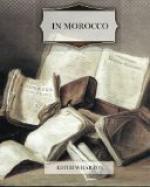With a good deal of ceremony, and after the customary pourparlers with the great Pasha who controls native affairs at Marrakech, an hour was fixed for our visit, and we drove through long lanes of mud-huts to a lost quarter near the walls. At last we came to a deserted square on one side of which stands the long low mosque of Mansourah with a turquoise-green minaret embroidered with traceries of sculptured terra cotta. Opposite the mosque is a gate in a crumbling wall; and at this gate the Pasha’s Cadi was to meet us with the keys of the mausoleum. But we waited in vain. Oriental dilatoriness, or a last secret reluctance to admit unbelievers to a holy place, had caused the Cadi to forget his appointment, and we drove away disappointed.
The delay drove us to wondering about these mysterious Saadian Sultans, who, though coming so late in the annals of Morocco, had left at least one monument said to be worthy of the Merinid tradition. And the tale of the Saadians is worth telling.
They came from Arabia to the Draa (the fruitful country south of the Great Atlas) early in the fifteenth century, when the Merinid empire was already near disintegration. Like all previous invaders they preached the doctrine of a pure Islamism to the polytheistic and indifferent Berbers, and found a ready hearing because they denounced the evils of a divided empire, and also because the whole of Morocco was in revolt against the Christian colonies of Spain and Portugal, which had encircled the coast from Ceuta to Agadir with a chain of fortified counting-houses. To bouter dehors the money-making unbeliever was an object that found adherents from the Rif to the Sahara, and the Saadian cherifs soon rallied a mighty following to their standard. Islam, though it never really gave a creed to the Berbers, supplied them with a war-cry as potent to-day as when it first rang across Barbary.
The history of the Saadians is a foreshortened record of that of all their predecessors. They overthrew the artistic and luxurious Merinids, and in their turn became artistic and luxurious. Their greatest Sultan, Abou-el-Abbas, surnamed “The Golden,” after defeating the Merinids and putting an end to Christian rule in Morocco by the crushing victory of El-Ksar (1578), bethought him in his turn of enriching himself and beautifying his capital, and with this object in view turned his attention to the black kingdoms of the south.
Senegal and the Soudan, which had been Mohammedan since the eleventh century, had attained in the sixteenth century a high degree of commercial wealth and artistic civilization. The Sultanate of Timbuctoo seems in reality to have been a thriving empire, and if Timbuctoo was not the Claude-like vision of Carthaginian palaces which it became in the tales of imaginative travellers, it apparently had something of the magnificence of Fez and Marrakech.




